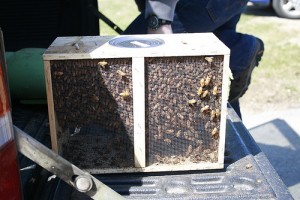Imbolc New Moon (Awakening)
Bees. Bees. Bees. Bees. I’ve had two 8 hour sessions of nothing but bees. And more stuff about bees.
Today I learned about dividing a colony, a successfully wintered colony, which is our situation here. As Marla Spivak says, “If you’re not sure, just let the bees do it.” That conforms to my work late last fall with the bees. Mark, my bee  mentor, had a traumatic autumn and we just didn’t get together quite enough.
mentor, had a traumatic autumn and we just didn’t get together quite enough.
Now, though, I understand the next step, which will create a parent colony–the old queen with two hive boxes–and a child colony, which I will treat in the same way I did the current one. That is, the goal with it will be to get to late fall with three hive boxes with a combination of brood, pollen and honey sufficient to see the child colony through this coming winter.
(2 lb package of bees)
Here’s the difficult part. The parent colony gets no care after the honey flow stops. This means that its queen will die of old age and since the colony will then have lost its egg layer, the entire colony will die out over the winter. There’s nothing cruel about this since it follows the essential biology of bees. That is, queens live around 2 years and the workers 60 days, so the entire colony would die out under any circumstances without a new queen and even if a new queen were added, the bees that would become the new colony under her reign would be entirely new bees.
There’s a big upside to this for all bees. We can clean out the old hive bodies and frames, check for disease and virus and if necessary we can burn the old frames and start over. This means that each bee colony will have a young, prolific queen and each hive will get a complete going over ever other year. Both of these elements, cleaning and a young, prolific queen increase the colonies capacity to survive and thrive.
The good news is that the parent colony begins making honey the minute the divide is complete. Honey supers go on the parent colony right away and they start filling up. A honey super is about half the size of a deep hive box and honey filled frames are their only result. A queen excluder is put on the parent colony deep hive boxes, so the queen does not crawl up in the honey supers and start laying eggs, therefore only honey ends up in them.
In addition to the divide Mark the bee mentor called and said he had an extra package of bees on the way. I agreed to buy it because I thought my bees were dead. Since they’re not, taking on another package of bees means we’ll end up with four hives next spring if everything goes well. At that point, we should be producing some serious honey, possibly enough to sell at farmer’s markets.
